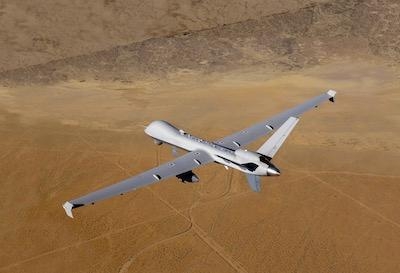Wed, Jan 15, 2020
Brake System Design Also Contributed To The Accident
The U.S. Air Force has released a report stating the cause of an accident involving an MQ-9A Reaper unmanned aircraft which departed a runway at an undisclosed location on September 3, 2018.

According to the report, the Mishap Aircraft (MA) was assigned to the 27th Special Operations Wing (SOW) at Cannon Air Force Base (AFB), New Mexico, and was flown by a Launch and Recovery Element (LRE) crew deployed to the undisclosed location from the 489th Attack Squadron (ATKS), 432nd Operations Group, 432nd Wing, Creech Air Force Base, Nevada.
The Mishap Crew (MC) received an “Engine – metal detected” red warning 10 minutes after takeoff, turned back towards the field and established an orbit to begin fuel dumping. Nine minutes later the engine oil pressure exceeded the limit of 126 pounds per square inch (psi) and the MC received a red warning. Per Aeronautical Systems Incorporated ASI-11114, Flight Manual, the MC elected to make an immediate straight-in landing using engine out procedures due to the possibility of catastrophic engine failure. Upon touchdown the propeller failed to go into reverse and the MA departed the prepared surface; according to Aeronautical Systems Incorporated ASI-11114, Flight Manual, the MQ-9A relies primarily on reverse thrust to slow and stop the aircraft upon landing.
After departing the runway, the MA caught fire and was destroyed with all modifications and four missiles. The resulting loss was valued at $12,726,187. There were no fatalities or damage to private property.
The Abbreviated Accident Investigation Board President found, by the preponderance of the evidence, the cause of the mishap to be the design of the engine. Further, the Board President found, by the preponderance of the evidence, the delay between engine Spectrometer Oil Analysis Program (SOAP) samples being taken and analyzed, as well as the design of the MQ-9A brake system, to be substantially contributing factors.
(Image from file)
More News
Known Traffic With respect to ATC clearances, means aircraft whose altitude, position, and intentions are known to ATC.>[...]
Aero Linx: Aviation Suppliers Association (ASA) Established February 25, 1993, the Aviation Suppliers Association (ASA), based in Washington, D.C., is a not-for-profit association,>[...]
Abeam An aircraft is “abeam” a fix, point, or object when that fix, point, or object is approximately 90 degrees to the right or left of the aircraft track. Abeam indic>[...]
Aero Linx: The Air Charter Safety Alliance The group, called the Air Charter Safety Alliance, will raise awareness of illegal charter flights among potential customers, charter bro>[...]
“For months, ALPA has been sounding the alarm on the ongoing efforts by some aircraft manufacturers to remove pilots from the flight deck and replace them with automation. To>[...]
 ANN's Daily Aero-Term (06.10.24): Known Traffic
ANN's Daily Aero-Term (06.10.24): Known Traffic ANN's Daily Aero-Linx (06.10.24)
ANN's Daily Aero-Linx (06.10.24) ANN's Daily Aero-Term (06.11.24): Abeam
ANN's Daily Aero-Term (06.11.24): Abeam ANN's Daily Aero-Linx (06.11.24)
ANN's Daily Aero-Linx (06.11.24) Aero-News: Quote of the Day (06.11.24)
Aero-News: Quote of the Day (06.11.24)



